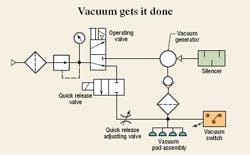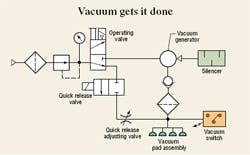Putting vacuum to work
Putting vacuum to work
Pneumatic systems depend on control valves and tubing to route the energy of compressed air to cylinders, air motors, and rotary actuators that press, move, twist, lift, and turn to perform some sort of work. Fragile objects — or those with delicate surfaces — must be pulled, rather than pushed or grabbed. For these applications, vacuum can be much more effective than any other technology.
Lifting with vacuum is limited by atmospheric pressure, vacuum cup area, and the physical characteristics of the object to be lifted. Therefore, vacuum technology lends itself most to objects that are light weight relative to their size. On the other hand, vacuum need not be restricted to lightweight objects. As long as an object has a large surface area relative to its size, vacuum can be an effective lifting or grabbing method that will not damage most surfaces.
For example, lifting a heavy refrigerator onto a wood base is easily accomplished using a manipulator equipped with multiple vacuum cups powered by a vacuum generator system. These lift-assist devices generally use a mechanical arm attached to a floor- or ceiling-mounted pedestal incorporating an air cylinder and mechanism that multiplies the operator applied force. A lifting motion by the operator causes the cylinder to assist in lifting, and the operator is free to raise, lower, or guide the refrigerator. If the operator removes his or her hands from the controls, the lifted object remains at rest. It can be moved manually into position, then raised or lowered by a return of hands to the controls.
Figure 1. Vacuum circuits use many of the same components as conventional pneumatic systems. A standard 3-port valve can energize and de-energize a vacuum generator, and a quick-release valve can route compressed air for blowoff.
The operator pushes a vacuum cup assembly against the refrigerator. When the cups touch the surface, a switch activates to route air flow to a vacuum generator. Because the arm already uses compressed air, simply tapping into the pneumatic system provides the power for vacuum. The vacuum circuit of an industrial manipulator is shown in Figure 1.
Vacuum level and surface area
The required vacuum lifting force is determined by the weight of the refrigerator. First, we must determine the best position for the vacuum pads to lift the refrigerator: top, sides, or a combination of both. The design should be such that lifting force from the vacuum cups is applied upward, not sideways. If the cups were to pull sideways on a heavy load, then move upward, gravity would tend to pull the load across the cups. This could cause the load to slide downward, across the cups, or shear the cups off. By lifting upwards, the cups will support the load in tension, which is how they are designed.
The next step is to set a vacuum level — in this case, 10-in. Assuming atmospheric pressure to be 29.92-in., 1 psia of lifting forces equates to 2.03-in. Hg of vacuum. So every 2-in. Hg of vacuum inside a vacuum cup can lift 1 lb per square inch of cup area. Thus, with 10-in. Hg. of vacuum inside the cup, we can lift 5 lb/in.2 of cup surface area.
If the refrigerator weighs 500 lb, then dividing the weight by the cup force per unit area gives a required cup area of 100 in.2
Using four cups will distribute the lifting force over a large portion of the refrigerator top. Dividing the required area by the number of cups gives the area per cup, or 25 in.2 A good rule is to have at least twice the required area as a safety factor. An area of 50 in.2 works out to an 8-in. diameter cup.
A vacuum generator can develop 20-in. Hg or higher, so we will have a total safety factor of more than four if necessary, (twice as much area as required and twice as much vacuum potential). This should be taken as a minimum safety factor due to the many variables involved, such as the seal between the cup and the load surface and any foreign material, such as dust or dirt, that may be on the surface. The only penalties for having too much cup area are cost and time to achieve vacuum. One dropped refrigerator will pay for many vacuum pads, and the costs skyrocket if someone is injured in the mishap. Always err on the side of being overly safe.
Keep it safe
To ensure a safe lift, a vacuum switch is added to the vacuum circuit between the pad and any filter to prevent the lifting cylinder from being energized unless 20-in. Hg is attained in the cup. It is important not to set this switch at too high a vacuum if machines will be used in high altitude areas — where the normal barometric pressure is about 24-in. Hg, rather than 29-in. It is easier to use a larger vacuum cup area than to pull a higher vacuum to achieve the same lifting force. The atmospheric pressure may change with altitude but the refrigerator always weighs the same.
The best number of cups to use in a given application is somewhat subjective — based primarily on past experience. Three points determine a plane, so this is a logical starting point, except in the case of cup failure. Four is a common number frequently found in lifting applications. If the object to be moved is limber — such as a 4-ft by 8-ft sheet of thin metal, many small cups is a better solution than a few large cups. The more likely that dirt or surface conditions will prevent cups from providing enough life, the more cups that should be used.
Other considerations
Another variable is design considerations. Should you provide an individual vacuum generator for each cup, or tie several pads together and use one generator? Again, the likelihood of failure is a primary consideration. What happens if the lifting mechanism doesn’t lift or lets go? Will an injury result, or simply an inconvenience? Providing a vacuum generator for each cup costs more, but it can be safer because failure of a single cup should not cause all of them to lose vacuum.
When practical, a filter should be provided in the vacuum circuit between the pad and the generator. If the work surfaces and atmosphere are clean, you can probably get along without one. It doesn’t harm the circuit or compromise the design, so it is usually included. However, if the filter element clogs, the vacuum switch will not function.
Finally, if cardboard cartons are being moved, the range of porosity from one type of cardboard to another should be determined and the size of vacuum generator chosen based on this number and the type of seal attained between the pad and the object to be moved. For example: If the vacuum generator is too small, it will not attain a predetermined vacuum level due to the flow from poor cup sealing caused by porosity.
A larger vacuum generator will correct this. Depending on the amount of flow involved, a multistage vacuum generator may be a valid solution. In general, a multistage vacuum generator will achieve higher flow than a single-stage one at the same vacuum level.
Manufacturer’s literature should contain flow curves for each vacuum generator. Measuring vacuum level and referring back to the flow curve will indicate the air flow. In general, the flow due to porosity will increase at higher vacuum levels, but leakage flow around the cup will tend to decrease due to the higher sealing forces.
A 12-in. cube of steel weighs almost 500 lb and can be hoisted with a 12-in. vacuum pad at 20-in. Hg with a safety factor of about 2. The same weight of steel in a flat sheet presents an entirely different problem that is easily solved. Large panes of glass are routinely handled with vacuum generators and four large pads. Weight is not the problem.
Surface area for vacuum cups is the limiting factor, assuming the packaging material is equal to the task.
Different parameters
Paperboard boxes are normally supplied in a flattened state and fed to a packaging machine through a magazine, Figure 2. Vacuum is used to erect the box from its flattened state to a rectangular shape, ends are folded in mechanically, and the box continues through the machine. Once the flattened box has been fed between two sets of vacuum cups, vacuum is applied, and two sides of the box are pulled apart to form a rectangle. Instead of contending with a heavy product, we now have a carton that tends to remain flat and must be quickly pulled into shape.
Two main forces are involved here: The inertia of the carton sides, and the air resistance that hinders motion of the two sides — air must flow between the two sides as the sides are quickly pulled apart. The faster the motion, the higher these two forces become. A small vacuum cup may suffice at low speeds, but larger ones are needed as speeds increase. Boxes have been erected for years, so the sizes and numbers of cups are well documented.
The use of a vacuum generator to produce the vacuum has several advantages. The off time is much longer than the on time, so minimal compressed air energy is wasted. Because of intermittent use, most packaging and similar applications are best served by a vacuum generator, rather than with a mechanical vacuum pump. The generator is “on” only when vacuum is required. The vacuum generator is also quiet, simple, compact, and relatively trouble free. No high voltage or current is required, and it is easily integrated into most the existing pneumatic system of most machines. Furthermore, production cycles often can be sped up simply by changing vacuum cup assemblies to suit the weight, size, and shape of a different box.
When service is required, it can be simplified because a compact vacuum generator can be installed close to its point of use. This close proximity allows using short hoses, which improves response times.
Vacuum accessories
Vacuum cups are used in most vacuum generator applications. They are usually made of Urethane, but are also available in Neoprene, silicone rubber, Viton, and other materials. The wide variety of materials ensures compatibility with the chemical environment, temperature, strength, and flexibility requirements of just about any application.
Vacuum switches provide an electrical signal to a solenoid valve when the designated vacuum level has been achieved, allowing the next sequential action to occur, such as actuating a cylinder to move the part picked up by the vacuum cup.
Vacuum release valves provide a small puff of compressed air to push a part off the vacuum cup, which improves cycle times and prevents lightweight parts from clinging to the vacuum cup. They usually can be adjustable over a range of flow-off times from 0.3 to 3.0 sec.
Silencers quiet the rush of exhaust air when the vacuum generator is operating.
Vacuum filter assemblies prevent paper dust, dirt, oil, or other contaminants from being sucked up through the vacuum cups and into the vacuum generator, which would degrade its efficiency.
This information was provided by George Morgan, of Gast Mfg. Co., Benton Harbor, Mich. For more information, click here to email, or call (269) 926-6171.



